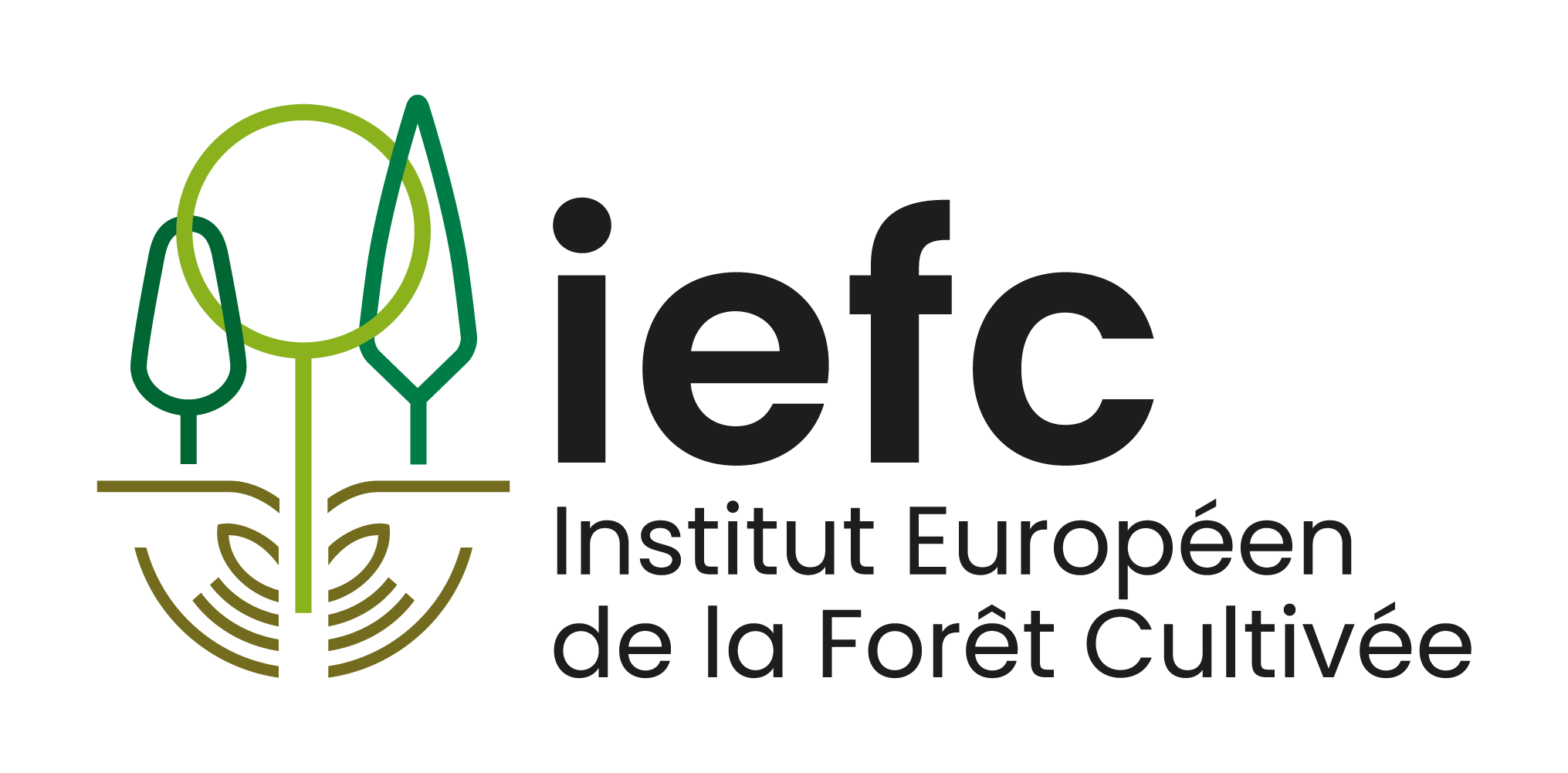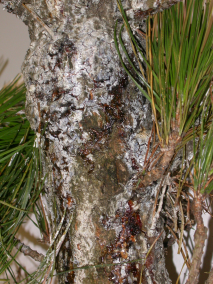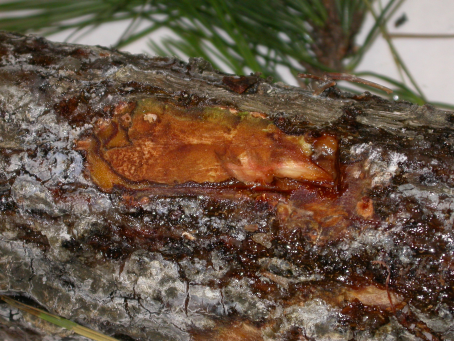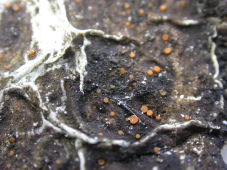Pitch Canker Disease
Fusarium circinatum (Asex.)
Sexual form: Gibberella circinata (Class Ascomycetes, Order Hypocreales)
Synonyms: Fusarium subglutinans.
Host tree
Many species of pines are affected by the disease. The most susceptible species are P. radiata and P. strobus, but P. halepensis, P. pinea, P. pinaster P. sylvestris or Pseudostuga menziesii may be affected by the disease.
Identification
- Dieback on the crow of the tree. Many dead shoots and branches appear when the disease is invading the tree.
- Visible resin flux appears over the trunk, giving the name of the disease (Photo 1).
- Dark necrosis appeared over the bark, developing typical cankers (Photo 2)
- The tree appeared with and evident decline appearance.
- The typical fructifications, orange sporodoquia (Photo 3), of the fungi are visible over the necrotic bark. The characteristics spores of Fusarium and polyphialida are easily visible by observation under the light microscope. The final identification requires molecular analyses in specialized labs.
Damage
- Tree vigour decreases, inducing tree susceptibility to another parasites as Sphaeropsis sapinea or bark beetles or Scirrhia pini.
- Fungal infections cause reduction of growth in both diameter and height on very susceptible species, as Pinus radiata.
- Tree death occurs if the fungus attacks severely during several years.
- The cones are affected, and the fungus is able to growth invading the internal tissues of the seeds. After that, the disease is easily transported to long distance by non certified seeds.
- As another Fusarium spp., F. circinatum is also a nursery disease and leads to the death of seedlings. The disease can be also easily transmitted to new nurseries and plantations by asymptomatic seedlings
Biology
Trees are infected by spores that survived in winter on shoots and twigs (particularly in warm climates) or by the spores produced by the sporodoquia during the vegetative period. Spores are transported by wind, water and also by insects of the Anobidae, Cercopidae and Scolytidae families. The European bark beetle species may have an active role in the spread of the disease. Orange pustules (sporodoquia) occur during the humidity periods, being this stage when the primary infections appear.
Risk factors
- Monoculture of pines susceptible to the pathogen. The homogeneous P. radiata plantations are highly susceptible to the Pitch Canker.
- The plantations in humidity warmer areas are very prone to the disease. However, due to the recent outbreak of this disease, many research assay is needed to determine the real hazard of the disease in the affected areas of Southern Europe
- hight stand density
- Rainy summer.
Pest management
Preventive measurements
-
- Avoid the establishment of nurseries and stands with high densities creating favourable microclimate conditions for Pitch Canker development.
- Avoid the establishment of new pine plantations in the areas previously affected by F. circinatum.
- Taking into account that the disease outbreak in Europe and in another countries of the world was due to a non-controlled package of seeds coming from affected areas, the accurate control over the seed provenance is essential to avoid the disease.
- Disease prevention must be based mainly on the selection and use of resistant genotypes. There are several cultivars with a good performance regarding wood production and quality, presenting tolerance to the pathogen. However, the percentage of resistance individuals in the native (natural) populations of some species as P. radiata, is quite low.
Curative control
They are not effective control measures to manage the diseases. The use of fungicides is only effective in nurseries.Further reading
AEGERTER, B. J.; GORDON, T. R.; STORER, A. J.; WOOD, D. L.2003. Pitch canker, a technical review - Publication 21616. University of California, april 2006. Available from berkeleyDWINELL, L. D.; BARROWS-BROADDUS, J. B.; KUHLMAN, E. G., 1985: Pitch canker: A disease complex of southern pines. Plant Disease 69, 270-276.
ENEBAK, S.A. AND STANOSZ, G.R., 2003. Response of conifer species of the Great Lakes region of North America to inoculation with the pitch canker pathogen Fusarium circinatum. Forest Pathology, 33(5), 333-338.
WIKLER, K.; STORER, A. J.; NEWMAN, W.; GORDON, T. R.; WOOD, D. L., 2003: The dynamics of an introduced pathogen in a native Monterey pine (Pinus radiata) forest. Forest Ecology and Management 179 (1/3), 209-221.



